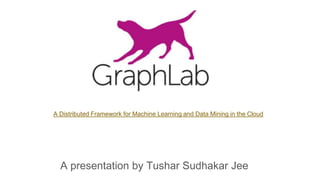
GraphLab
- 1. A presentation by Tushar Sudhakar Jee A Distributed Framework for Machine Learning and Data Mining in the Cloud
- 27. Distributed Data Graph •A graph is partitioned into k parts where k is much greater than the number of machines. •Each part, called an atom is stored as a separate file on a distributed storage system(Amazon S3).
- 29. •It uses vertex coloring to satisfy the edge consistency model by executing synchronously all vertices of the same color in the vertex set T before proceeding to the next color. •Full consistency model is satisfied by ensuring that no vertex shares the same color as any of its distance two neighbors. •Vertex consistency model is satisfied by assigning all vertices the same color. • It executes the set of scheduled vertices T partially asynchronously. Chromatic Engine: Edge Consistency model using Chromatic Engine.
- 36. System design ● In the Initialization phase the atom file representation of data graph is constructed. ● In the GraphLab Execution Phase atom files are assigned to individual execution engines from the DFS.
- 38. Applications ● Netflix Movie Recommendation ● Video Co-segmentation(Coseg) ● Named Entity Recognition(NER)
- 39. Netflix Movie Recommendation ● It makes use of collaborative filtering to predict the movie ratings for each user based on the ratings of similar users. ● The alternating least squares(ALS) algorithm is used to iteratively compute a low-rank matrix factorization. ● The sparse matrix R defines a bipartite graph connecting each user with the movies that they rated. ● Vertices are users(rows U) and movies(columns V) and edges contain the ratings for a user-movie pair. ● GraphLab update function predicts ratings(edge- values).
- 41. •R = {rij }nu ×nv is user-movie matrix where each item Rij represents the rating score of item j by user i where ri,j =< ui,vj > ∀i,j. • U represent the user feature matrix and V represent the movie feature matrix. • Dimension of the feature space(d) is a system parameter that is determined by a hold- out dataset or cross- validation. • The low rank approximation problem is thus formulated as follows to learn the factor vectors (ui,vj): Where pi,j =<ui,vj > is the predicted rating ,λ is the regularization coefficient and K is the Set of known ratings from the Sparse matrix R.
- 48. Named Entity Recognition(NER) • Named Entity Recognition is the task of determining the type (e.g., Person, Place, or Thing) of a noun-phrase (e.g. Obama, Chicago, or Car) from its context (e.g. “President..”, “Lives near..”, or “bought a..”). • The Data graph for NER is bipartite with one set of vertices corresponding to noun-phrases and the other to contexts. •The CoEM vertex program updates estimated distribution for a vertex (either noun-phrase or context) based on the current distribution for neighboring vertices.
